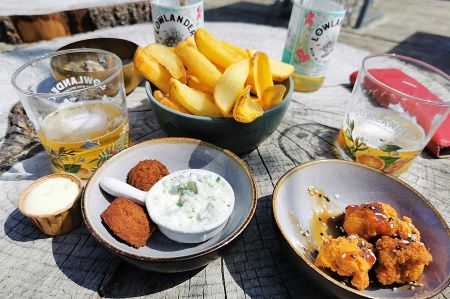Dutch cuisine – fast food completely different!
- Written by Portal Editor
Hardly any national cuisine is free of influences from the neighbourhood or even from far away. Dutch cuisine also has strong overlaps with the cuisines of neighbouring regions.
Depending on your current location in Holland, there are connections, for example, to East Frisian, but also to Rhenish and Flemish cuisine, which doesn't mean anything negative. Traditional Dutch cuisine has always been characterized by simple and hearty dishes; Important ingredients were vegetables, milk, butter, cheese, meat and fish.
Dutch cuisine enhanced by Indonesian influences
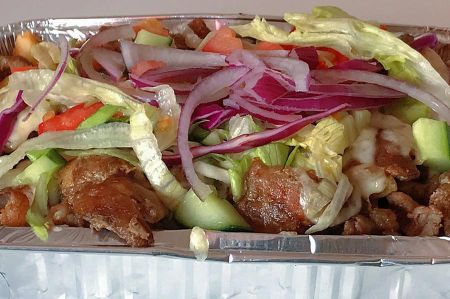 Since the 17th century, the so-called Golden Age, the cuisine of merchants in particular was characterized by rich and overflowing tables with hearty and heavy dishes. At the same time, however, it also contains a large number of salads, hearty vegetable stews and dairy products from the rural population. At the beginning of the 20th century, Dutch cuisine was primarily supplemented by Indonesian influences, as Indonesia, as the Dutch East Indies, was a Dutch colony for a long time. The snack culture with numerous fried foods and the typical “snack bars” has also become very popular in recent decades, especially in urban regions.
Since the 17th century, the so-called Golden Age, the cuisine of merchants in particular was characterized by rich and overflowing tables with hearty and heavy dishes. At the same time, however, it also contains a large number of salads, hearty vegetable stews and dairy products from the rural population. At the beginning of the 20th century, Dutch cuisine was primarily supplemented by Indonesian influences, as Indonesia, as the Dutch East Indies, was a Dutch colony for a long time. The snack culture with numerous fried foods and the typical “snack bars” has also become very popular in recent decades, especially in urban regions.
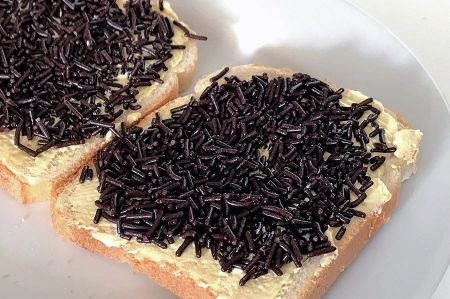 In fast food restaurants you get French fries (patat, also friet or frietjes) with mayonnaise, ketchup (also mixed with onions = speciaal/special) or other sauces such as peanut sauce (pindasaus/satésaus) or Joppie sauce, a mixture of mayonnaise, curry and onions. In recent years in particular, variants of traditional snack dishes have emerged, such as: B. Kapsalon (“hairdressing salon”), a combination of French fries, kebab meat and salad, layered on a plate and, in some snack bars, gratinated with cheese.
In fast food restaurants you get French fries (patat, also friet or frietjes) with mayonnaise, ketchup (also mixed with onions = speciaal/special) or other sauces such as peanut sauce (pindasaus/satésaus) or Joppie sauce, a mixture of mayonnaise, curry and onions. In recent years in particular, variants of traditional snack dishes have emerged, such as: B. Kapsalon (“hairdressing salon”), a combination of French fries, kebab meat and salad, layered on a plate and, in some snack bars, gratinated with cheese.
Typical snacks are the Frikandel,...
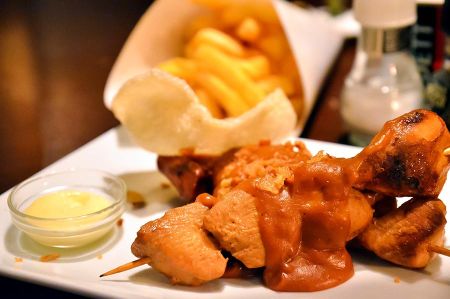 The Netherlands is known today primarily for its so-called snack culture, which can be seen in numerous snack bars, in the Netherlands “snack bars”. In addition to the French fries from Belgium, the snack bars also offer various fried meat and cheese dishes. Typical snacks are the Frikandel (or Frikandel speciaal), Kroket (with beef, veal, vegetable, goulash or chicken filling), Bami- or Nasischijf or Bami- or Nasibal (a disc or ball covered in breading and fried Bami Goreng or Nasi Goreng), Kaassoufflé, Kipcorn, Bitterballen, Gehaktbal and in the coastal towns Kibbeling, fried plaice or “Lekkerbekje” (pangasius or whiting fried) and various other fish dishes.
The Netherlands is known today primarily for its so-called snack culture, which can be seen in numerous snack bars, in the Netherlands “snack bars”. In addition to the French fries from Belgium, the snack bars also offer various fried meat and cheese dishes. Typical snacks are the Frikandel (or Frikandel speciaal), Kroket (with beef, veal, vegetable, goulash or chicken filling), Bami- or Nasischijf or Bami- or Nasibal (a disc or ball covered in breading and fried Bami Goreng or Nasi Goreng), Kaassoufflé, Kipcorn, Bitterballen, Gehaktbal and in the coastal towns Kibbeling, fried plaice or “Lekkerbekje” (pangasius or whiting fried) and various other fish dishes.
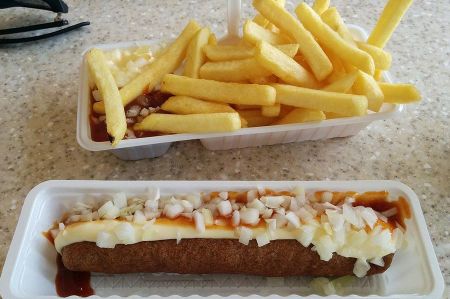 Indonesian cuisine has been established through the influences of the colonial era. Patat oorlog e.g. B. is fries with mayo, onions and peanut sauce (oorlog means war, but in this dish it stands for the chaotic combination of ingredients, which is reminiscent of a battlefield).
Indonesian cuisine has been established through the influences of the colonial era. Patat oorlog e.g. B. is fries with mayo, onions and peanut sauce (oorlog means war, but in this dish it stands for the chaotic combination of ingredients, which is reminiscent of a battlefield).
Indonesian influences such as peanut sauce are hard to miss in Dutch cuisine, even though most dishes have been adapted to European tastes (i.e. little salt and not too spicy).
Bitterballen
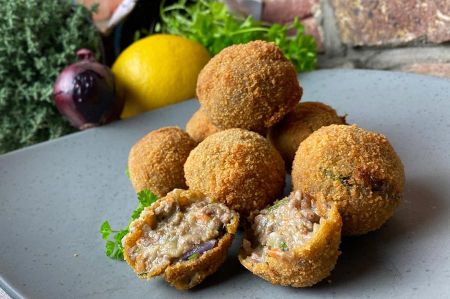 Bitterballen, also called “Dutch meatballs,” are the Dutch’s favorite finger food, along with mini spring rolls and Gouda cheese cubes.
Bitterballen, also called “Dutch meatballs,” are the Dutch’s favorite finger food, along with mini spring rolls and Gouda cheese cubes.
Traditionally they are made from beef, but there are also variations made from veal, chicken or mushrooms. Grainy mustard is often served as a dip with these breaded and fried balls.
Croquet
The Kroket or Vleeskroket is a popular snack that is very similar to the croquette known in Germany, at least in appearance. However, the Dutch version has a meaty filling made from finely ground meat, stock, herbs, spices, flour and butter.
Stroopwafel
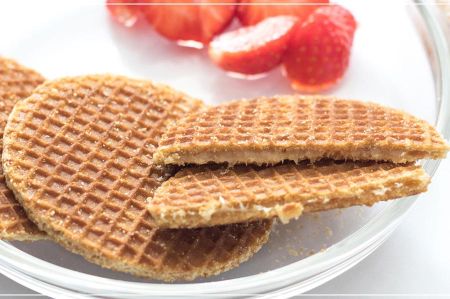 If you want to try something really sweet and typically Dutch, then stroopwafels (syrup waffles) are just the thing.
If you want to try something really sweet and typically Dutch, then stroopwafels (syrup waffles) are just the thing.
Two thin waffles held together by a layer of delicious caramel syrup. Stroopwafels taste best warm and freshly baked at a street market or from a bakery.
Thick Dutch fries
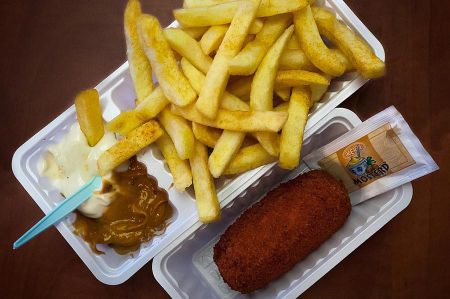 Unlike 'ordinary' fries, these are actually very tasty! The so-called patat or fries taste simply wonderful: nice and thick, crispy on the outside and still soft on the inside. You usually buy them in paper bags and choose ingredients according to your own taste. If you order a portion of 'patatje oorlog' you will get a mix of peanut satay sauce, mayo and onions on the fries, and with 'patat speciaal' there will be a mix of curry ketchup, mayonnaise and onions on top.
Unlike 'ordinary' fries, these are actually very tasty! The so-called patat or fries taste simply wonderful: nice and thick, crispy on the outside and still soft on the inside. You usually buy them in paper bags and choose ingredients according to your own taste. If you order a portion of 'patatje oorlog' you will get a mix of peanut satay sauce, mayo and onions on the fries, and with 'patat speciaal' there will be a mix of curry ketchup, mayonnaise and onions on top.
Raw herring
The thought of raw herring may not make everyone's mouth water, but herring is a must when visiting Amsterdam. There are herring stalls and fish shops all over the city - ask for a 'broodje haring' and they'll give you a fish sandwiched in a small roll and served with pickles and onions. The best time to eat herring is from May to July, when the herring - according to real connoisseurs - tastes sweetest.
Please read as well:
